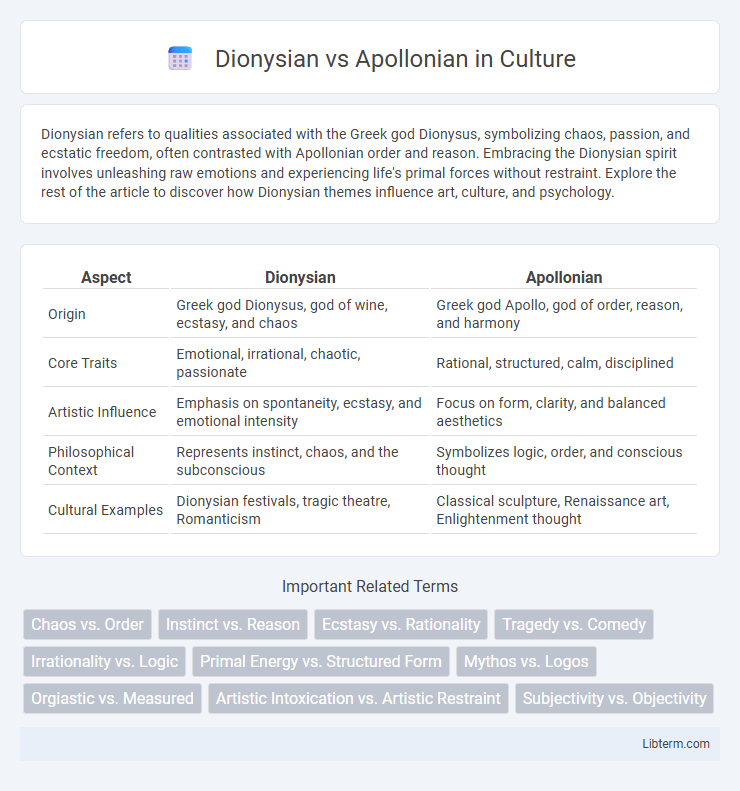Dionysian refers to qualities associated with the Greek god Dionysus, symbolizing chaos, passion, and ecstatic freedom, often contrasted with Apollonian order and reason. Embracing the Dionysian spirit involves unleashing raw emotions and experiencing life's primal forces without restraint. Explore the rest of the article to discover how Dionysian themes influence art, culture, and psychology.
Table of Comparison
| Aspect | Dionysian | Apollonian |
|---|---|---|
| Origin | Greek god Dionysus, god of wine, ecstasy, and chaos | Greek god Apollo, god of order, reason, and harmony |
| Core Traits | Emotional, irrational, chaotic, passionate | Rational, structured, calm, disciplined |
| Artistic Influence | Emphasis on spontaneity, ecstasy, and emotional intensity | Focus on form, clarity, and balanced aesthetics |
| Philosophical Context | Represents instinct, chaos, and the subconscious | Symbolizes logic, order, and conscious thought |
| Cultural Examples | Dionysian festivals, tragic theatre, Romanticism | Classical sculpture, Renaissance art, Enlightenment thought |
Introduction to Dionysian and Apollonian Concepts
Dionysian and Apollonian concepts originate from Nietzsche's philosophy, representing two fundamental forces shaping human experience. The Dionysian embodies chaos, emotion, instinct, and the irrational aspects of life, linked to the god Dionysus and primal ecstasy. The Apollonian symbolizes order, reason, harmony, and structured beauty, associated with the god Apollo and rationality.
Origins in Greek Mythology and Philosophy
The concepts of Dionysian and Apollonian originate from Greek mythology, representing the duality between the god Dionysus, symbolizing chaos, ecstasy, and irrationality, and Apollo, embodying order, harmony, and rationality. In philosophy, Friedrich Nietzsche popularized these opposing forces as metaphors in his work "The Birth of Tragedy," where the Apollonian reflects structured reason and the Dionysian channels primal instinct and creative chaos. This dichotomy illustrates the tension underlying Greek art, culture, and human experience, highlighting the interplay between reason and emotion in shaping civilization.
Nietzsche’s Interpretation in "The Birth of Tragedy
Nietzsche's interpretation in "The Birth of Tragedy" contrasts the Dionysian and Apollonian as fundamental artistic forces representing chaos and order, respectively. The Dionysian embodies primal ecstasy, irrationality, and emotional excess, while the Apollonian symbolizes reason, harmony, and structured beauty. Nietzsche argues that Greek tragedy emerges from the tension and synthesis of these opposing forces, revealing profound insights into human nature and existence.
Key Characteristics of the Dionysian Spirit
The Dionysian spirit embodies chaos, emotional intensity, and the dissolution of individual boundaries through ecstatic experiences, emphasizing instinct, spontaneity, and the primal aspects of human nature. It celebrates the irrational, the unconscious, and the transformative power of art, particularly as seen in music, dance, and ritualistic festivities. This contrasts sharply with the Apollonian focus on order, reason, and harmony, highlighting a deep cultural tension between liberation and structure in human experience.
Defining Apollonian Qualities
The Apollonian qualities embody order, rationality, and harmony, emphasizing clarity and structured beauty rooted in logic and reason. This concept originates from Apollo, the Greek god associated with light, truth, and prophecy, representing restraint and disciplined creativity. In contrast to Dionysian chaos and emotional excess, Apollonian traits prioritize balance and intellectual control in art and culture.
The Dynamic Tension: Chaos vs. Order
The dynamic tension between Dionysian and Apollonian principles embodies the contrast between chaos and order, where Dionysian energy represents irrationality, ecstasy, and creative destruction, while Apollonian forces emphasize reason, harmony, and structured form. This interplay fuels artistic expression and philosophical inquiry, reflecting the balance necessary for cultural and psychological development. Nietzsche's exploration of this dichotomy highlights how the synthesis of these opposing forces produces profound human experiences and societal progress.
Influence in Art, Literature, and Culture
The Dionysian and Apollonian duality profoundly influences art, literature, and culture by representing contrasting forces of chaos and order, emotion and reason. The Dionysian embodies spontaneity, ecstasy, and irrationality, inspiring vibrant, passionate artistic expressions such as expressionism and romantic literature. In contrast, the Apollonian symbolizes harmony, structure, and logic, shaping classical art, realistic narratives, and architectural precision that emphasize balance and clarity.
Modern Applications of Dionysian and Apollonian Duality
Modern applications of the Dionysian and Apollonian duality are evident in psychology, art, and cultural studies, where the Dionysian represents chaos, emotion, and instinct, while the Apollonian symbolizes order, reason, and structure. Contemporary therapy often integrates these concepts by balancing emotional expression with rational control to promote mental health. In creative industries, artists and designers harness the Dionysian drive to inspire innovation, tempered by Apollonian principles to ensure coherence and clarity in their work.
Contemporary Debates and Critiques
Contemporary debates on the Dionysian versus Apollonian dichotomy often challenge the rigid binary established by Nietzsche, emphasizing fluidity and intersection rather than opposition. Critics argue that the strict separation oversimplifies human experience, advocating for a more nuanced understanding that integrates both ecstatic creativity and rational order. Recent scholarship explores the dynamic interplay in modern cultural expressions, highlighting hybridity as a key to interpreting art, identity, and social behavior.
Conclusion: The Balance of Opposites
The balance between Dionysian and Apollonian elements represents the harmony of chaos and order, emotion and reason, instinct and structure within human experience. Achieving this equilibrium fosters creativity, self-awareness, and cultural vitality by integrating primal energy with rational thought. Embracing both forces allows individuals and societies to navigate complexity and pursue holistic growth.
Dionysian Infographic

 libterm.com
libterm.com